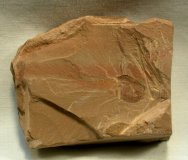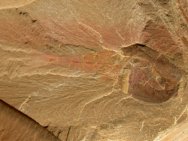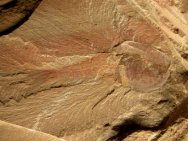Waptia
(Chuandianella) ovata
Phylum Arthropoda
Geological
Time: Early Cambrian (~525 million years ago)
Size: 28
mm
Fossil
Site: Chengjiang Maotianshan Shales, Quiongzhusi Section, Yu’anshan
Member, Heilinpu Formation, Haiyi Village, Anning, Kunming County, Yunnan
Province, China
| 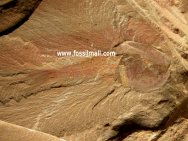 Description:
This unusual arthropod is known as Waptia ovata. The species is
known mostly from the distinctive wrinkled carapace. The discovery
of the Chengjiang Biota by Hou Xian-guang in 1984 opened a window
onto a remarkable array of lifeforms from what is termed the Cambrian
Explosion. The diversity of soft-tissue fossils is astonishing:
algae, medusiforms, sponges, priapulids, annelid-like worms, echinoderms,
arthropods (including trilobites), hemichordates, chordates, and
the first agnathan fish make up just a small fraction of the total.
Numerous problematic forms are known as well, some of which may
have represented failed attempts at diversity that did not persist
to the present day. Description:
This unusual arthropod is known as Waptia ovata. The species is
known mostly from the distinctive wrinkled carapace. The discovery
of the Chengjiang Biota by Hou Xian-guang in 1984 opened a window
onto a remarkable array of lifeforms from what is termed the Cambrian
Explosion. The diversity of soft-tissue fossils is astonishing:
algae, medusiforms, sponges, priapulids, annelid-like worms, echinoderms,
arthropods (including trilobites), hemichordates, chordates, and
the first agnathan fish make up just a small fraction of the total.
Numerous problematic forms are known as well, some of which may
have represented failed attempts at diversity that did not persist
to the present day.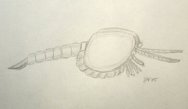
The
systematic position of this taxon has undergone several revisions.
It was originally placed within the Ostracodiform genus Mononotella,
then later referred to a new genus Chaundianella. More recent finds
of remains other than the carapace have shown it to be similar to
the Burgess Shale genus Waptia. While the species is known from
other Lower Cambrian locations in Yunnan, Sichuan, Guizhou, and
Shaanxi Provinces, only those from the Chengjiang Biota are known
to show soft part preservation (notice the gut line and segmentation)
such as you see here, making it a highly desirable specimen.
|
|


